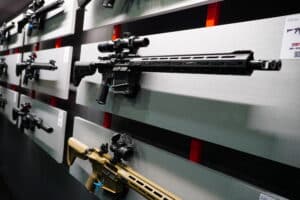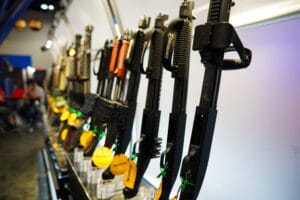Firearms commerce has substantially increased over the past two decades as the number of licensed firearms manufacturers and firearms sold to the general public have soared.
That is according to a lengthy report from the Bureau of Alcohol, Tobacco, Firearms, and Explosives (ATF) released on Tuesday. The report, which covers the period from 2000 through 2020, revealed that domestically manufactured firearms have increased by 187 percent, firearms exported from U.S. manufacturers by 240 percent, and firearms imported into the U.S. from foreign manufacturers by 350 percent.
The ATF reported that approximately 3.9 million new firearms were manufactured in 2000, a number that climbed to 11.3 million in 2020. That equated to roughly 1,397 new guns per 100,000 persons in 2000 but jumped to around 3,410 per 100,000 in 2020.
The growth in the industry is the latest indication of how interest in gun ownership has grown in recent years. Along with increased background checks, the report shows more Americans are buying more guns than in recent history. The growth will likely affect gun politics over the long run since gun owners tend to oppose gun restrictions more than those who don’t own firearms.
Over the same time frame, the overall number of individuals or entities obtaining a federal firearms license (FFL) has increased by 22 percent. A substantial portion of those hold a Type 07 FFL to manufacture firearms.
There were only 2,074 Type 07 FFLs in 2000, comprising less than 2 percent of all FFLs. That number had increased to 5,169 by 2010 and, as of 2020, stood at 16,473. That’s slightly more than 11 percent of all FFLs.
The most explosive growth has been seen among newly manufactured handguns sold in America. They climbed from around 1 million in 2000 to more than 5.5 million in 2020, becoming the most dominant type–about 50 percent–of all firearms sold.
At the same time, there were nearly 1.6 million rifles produced and sold in the U.S. in 2000, spiking to 4.2 million in 2016 before declining to slightly less than 2.8 million in 2020.
Also of note is a reported 4,281 percent surge in the manufacture and sale of what the ATF classifies as “miscellaneous firearms.” That category encompasses incomplete frames and receivers or parts kits that people can purchase and build for themselves. Only 30,238 of those miscellaneous parts were sold in 2000 compared to more than 1.3 million in 2020, with most of that surge coming after 2010.
The charts displaying the growth in firearms manufacturing show sharp upticks that coincide with major political events. The report shows a surge in gun making during former President Barack Obama’s tenure in office and an even sharper spike during the 2016 election. It shows another surge during 2020 that could be attributed to the election, the pandemic, and the wave of protests and riots that swept the nation during the summer.
The ATF did address a surge in handgun manufacturing which saw pistols surpass rifles and shotguns as the predominant type of firearm in the country beginning around 2009. The agency linked that change to two landmark Supreme Court decisions on the right to own handguns, 2008’s D.C. v. Heller and 2010’s McDonald v. Chicago.
The report is part of a broader National Firearms Commerce and Trafficking Assessment.
An ATF press release accompanying the report noted that it was just Volume 1 of an expected four-volume series. The agency is undertaking a “comprehensive examination of commerce in firearms and the diversion of firearms to illegal markets.” The bureau further noted the other reports would be delivered shortly and they would be updated on an annual basis going forward.
“The first volume published today provides critical, data-driven insights on firearms commerce and technology trends that will inform our efforts to understand and disrupt gun trafficking networks,” Attorney General Merrick Garland said in the statement.”We will continue to work alongside our partners to provide valuable lessons that will help agents, prosecutors, and policymakers tackle modern criminal gun trafficking enterprises.”







2 Responses
One question regarding the Podcast on Alan West: Is there something we can do to convince the current Board of Directors who will attend to vote him in as EVP or are we just screwed with the NRA keeping Wayne LePierr remaining in office?
I had met Wayne years ago at a local Friends of NRA event in Leiminster MA. He’s very likeable, articulate and one who has served the NRA in so many wonderful ways. I feel bad even saying he should go, but it is time for fresh leadership and recognition for his many decades of service. Still he must go.
Your best bet is to try voting in directors who are advocating for change or trying to contact the current directors. There have been some organized efforts to do those things with groups like Save the Second. But they’ve had very little success so far.